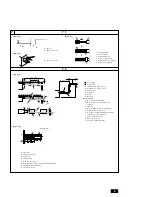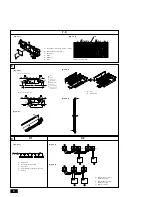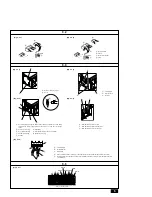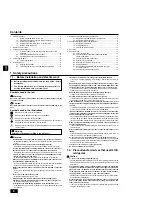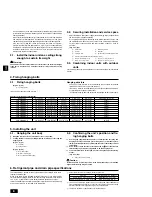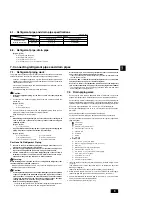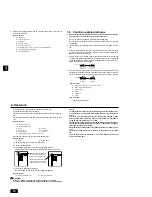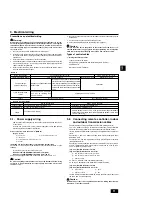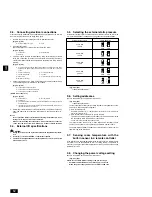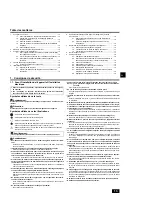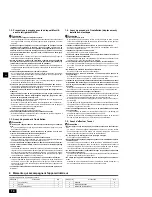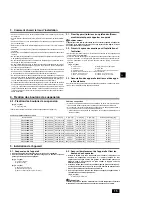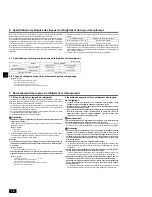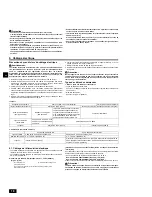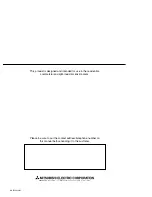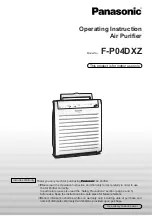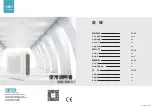
9
GB
D
F
E
I
NL
GR
RU
TR
CZ
SV
HG
PO
•
Store the piping to be used during installation indoors and keep both
ends of the piping sealed until just before brazing.
- If dust, dirt, or water gets into the refrigerant cycle, the oil will deteriorate and
the compressor may fail.
•
Use Suniso 4GS or 3GS (small amount) refrigerator oil to coat the flare
and flange connection part. (For models using R22)
•
Use ester oil, ether oil or alkylbenzene (small amount) as the refrigerator
oil to coat flares and flange connections. (For models using R410A or R407C)
- The refrigerant used in the unit is highly hygroscopic and mixes with water
and will degrade the refrigerator oil.
7.2. Drain piping work
•
Ensure that the drain piping is downward (pitch of more than 1/100) to the
outdoor (discharge) side. Do not provide any trap or irregularity on the way.
•
Ensure that any cross-wise drain piping is less than 20 m [65 ft] (excluding the
difference of elevation). If the drain piping is long, provide metal braces to prevent
it from waving. Never provide any air vent pipe. Otherwise drain may be ejected.
•
Use a hard vinyl chloride pipe O. D. ø32 mm [1-1/4 in] for drain piping.
•
Ensure that collected pipes are 10 cm [3-15/16 in] lower than the unit body’s
drain port.
•
Do not provide any odor trap at the drain discharge port.
•
Put the end of the drain piping in a position where no odor is generated.
•
Do not put the end of the drain piping in any drain where ionic gases are generated.
[Fig. 7.2.1] (P.3)
Correct piping
Wrong piping
A
Insulation (9 mm [3/8 in] or more)
B
Downward slope (1/100 or more)
C
Support metal
K
Air bleeder
L
Raised
M
Odor trap
Grouped piping
D
O. D. ø32 mm [1-1/4 in] PVC TUBE
E
Make it as large as possible. About 10 cm [3-15/16 in].
F
Indoor unit
G
Make the piping size large for grouped piping.
H
Downward slope (1/100 or more)
I
O. D. ø38 mm [1-1/2 in] PVC TUBE for grouped piping.
(9 mm [3/8 in] or more insulation)
J
Up to 550 mm [21-11/16 in]
N
Drain hose (accessory)
O
Horizontal or slightly upgradient
1.
Insert the drain hose (accessory) into the drain port (insertion margin: 32 mm
[1-1/4 in]).
(The drain hose must not be bent more than 45° to prevent the hose from
breaking or clogging.)
(Attach the hose with glue, and fix it with the band (small, accessory).)
2.
Attach the drain pipe (O.D. ø32 mm [1-1/4 in] PVC TUBE PV-25, field supply).
(Attach the pipe with glue, and fix it with the band (small, accessory).)
3.
Perform insulation work on the drain pipe (O.D. ø32 mm [1-1/4 in] PVC TUBE
PV-25) and on the socket (including elbow).
4.
Check the drainage. (Refer to [Fig. 7.3.1])
7. Connecting refrigerant pipes and drain pipes
7.1. Refrigerant piping work
This piping work must be done in accordance with the installation manuals for both
outdoor unit and BC controller (simultaneous cooling and heating series R2).
•
Series R2 is designed to operate in a system that the refrigerant pipe from an
outdoor unit is received by BC controller and branches at the BC controller to
connect between indoor units.
•
For constraints on pipe length and allowable difference of elevation, refer to
the outdoor unit manual.
•
The method of pipe connection is brazing connection.
Caution:
•
Install the refrigerant piping for the indoor unit in accordance with the
following.
1. Cut the tip of the indoor unit piping, remove the gas, and then remove the
brazed cap.
[Fig. 7.1.1] (P.3)
A
Cut here
B
Remove brazed cap
2. Pull out the thermal insulation on the site refrigerant piping, braze the unit
piping, and replace the insulation in its original position.
Wrap the piping with insulating tape.
Note:
•
When blazing the refrigerant pipes, be sure to blaze, after covering a wet
cloth to the pipes of the units in order to prevent it from burning and
shrinking by heat.
[Fig. 7.1.2] (P.3)
A
Cool by a wet cloth
•
Pay strict attention when wrapping the copper piping since wrapping the
piping may cause condensation instead of preventing it.
[Fig. 7.1.3] (P.3)
A
Thermal insulation
B
Pull out insulation
C
Wrap with damp cloth
D
Return to original position
E
Ensure that there is no gap here
F
Wrap with insulating tape
Cautions On Refrigerant Piping
Be sure to use non-oxidative brazing for brazing to ensure that no for-
eign matter or moisture enter into the pipe.
Be sure to apply refrigerating machine oil over the flare connection seat-
ing surface and tighten the connection using a double spanner.
Provide a metal brace to support the refrigerant pipe so that no load is
imparted to the indoor unit end pipe. This metal brace should be pro-
vided 50 cm away from the indoor unit’s flare connection.
Warning:
When installing and moving the unit, do not charge it with refrigerant other
than the refrigerant specified on the unit.
- Mixing of a different refrigerant, air, etc. may cause the refrigerant cycle to mal-
function and result in severe damage.
Caution:
•
Use refrigerant piping made of C1220 (Cu-DHP) phosphorus deoxidized
copper as specified in the JIS H3300 “Copper and copper alloy seamless
pipes and tubes”. In addition, be sure that the inner and outer surfaces
of the pipes are clean and free of hazardous sulphur, oxides, dust/dirt,
shaving particles, oils, moisture, or any other contaminant.
•
Never use existing refrigerant piping.
- The large amount of chlorine in conventional refrigerant and refrigerator oil
in the existing piping will cause the new refrigerant to deteriorate.
6.1. Refrigerant pipe and drain pipe specifications
6.2. Refrigerant pipe, drain pipe
[Fig. 6.2.1] (P.2)
A
Refrigerant pipe (liquid pipe)
B
Refrigerant pipe (gas pipe)
C
Drain pipe (O.D. ø32 [1-1/4 in])
D
Drain pipe (O.D. ø32 [1-1/4 in], spontaneous draining)
Model
PEFY-P·NMAU-E
Item
06·08·12·15·18
24·27·30·36·48·54
Liquid pipe
ø 6.35 [1/4]
ø 9.52 [3/8]
Gas pipe
ø 12.7 [1/2]
ø 15.88 [5/8]
Drain pipe
O.D. ø 32 [1-1/4]
Refrigerant pipe
(Brazing connection)
(Unit: mm [in])
01_KB79P491H01_GB.p65
6/23/09, 4:22 PM
9



